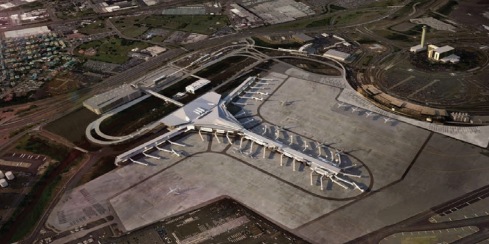AIRPORT COOPERATIVE RESEARCH PROGRAM
 As needs change and deterioration occurs, many airport terminals may no longer function as originally intended. Several factors can support the need for redevelopment of a terminal facility.
As needs change and deterioration occurs, many airport terminals may no longer function as originally intended. Several factors can support the need for redevelopment of a terminal facility.
For example, building age and physical condition can prompt the need for terminal renovation. New regulations may direct airports to reorganize terminals to maximize the utilization of all available space. Terminals also are commonly refurbished to improve functionality and the travelers’ experience. With changes in airport security, some terminal floor plans are unable to make accommodations for additional terminal operations such as security screening checkpoints. Furthermore, some airports may choose to plan terminal redevelopment to improve overall aesthetic appeal.
As time progresses, a combination of these motivating factors can result in terminals that, although structurally sound, are ultimately outdated. Terminals may go through a series of renewals that upgrade structural or aesthetic components, mechanical processes, and informational technology systems. Such improvements can be costly, require extra airport space to accommodate construction, and can disrupt airport operations. Therefore, many factors need to be assessed and thoroughly evaluated before determining whether to replace or simply renew an airport terminal.
ACRP Report 68: Guidebook for Evaluating Terminal Renewal Versus Replacement Options (2012) is a resource to assist airports in evaluating the costs and benefits associated with renewing or replacing a terminal. The guidebook outlines an objective, four-step process to help identify and assess available options to facilitate informed decision making.
Airport personnel from the Port Authority of New York and New Jersey (PANYNJ) utilized ACRP Report 68 for the redevelopment planning of Terminal A at Newark Liberty International Airport (EWR). Planning for the redevelopment of this terminal, which had been conducted at various times over a 10-year period, was resumed in June 2012. The airport team was tasked with comparing the costs and benefits associated with renewal or replacement of Terminal A. The terminal, which was constructed more than four decades ago, was in need of a complete update of mechanical, electrical, and information systems. The airport could choose to either renovate the existing facility or completely relocate the terminal to a new location.
The four-step evaluation process recommended by ACRP Report 68 includes:
- Step 1: Determine Need for Terminal Redevelopment
- Step 2: Refine Terminal Redevelopment Objectives and Generate Options
- Step 3: Evaluate Options
- Step 4: Document Results of the Analyses
In accordance with Step 1 goals, the PANYNJ team first determined the need for a terminal redevelopment program, which would extend the facility’s life one to three decades. As outlined in the guidebook, the team identified the gap between current facility operations and facility requirements identified in the program definition report (PDR). The team reviewed available funding and developed a plan to successfully meet future expectations. Facility improvement requirements also were identified to assure that high-quality service was maintained and operating expenses were controlled. PANYNJ also identified immediate terminal needs to be addressed, including the determination that the current terminal structure was inflexible for check-in processing, passenger security screening, TSA baggage screening, hold rooms, and concessions.
Following the goals of Step 2, the team next refined the terminal redevelopment objectives and generated concept options for terminal planning and development. According to PANYNJ, the main priority for the Terminal A redevelopment team was to obtain a new perspective on the project. As outlined in the guidebook, the team developed multiple terminal configurations for both the renewal and replacement of the terminal. As advised in ACRP Report 68, the team utilized brainstorming sessions in the form of workshops with stakeholders to review and refine these options.
When options are evaluated in Step 3, the guidebook urges practitioners to make decisions based on businessdriven considerations rather than solely on costs by assessing both qualitative and quantitative factors for each option. With regard to qualitative factors, the PANYNJ team established the amount that each option helped accomplish airport facility goals and sustainability initiatives.
The team also developed a comparative matrix, similar to Table 9-2 in ACRP Report 68, to assess the performance of each option. Information in the matrix included level of service, impact on airport operations during construction, and primary space functions. To assess quantitative factors, cost estimates for all three options were evaluated, along with preliminary construction schedules.
Download full version (PDF): Evaluating Terminal Renewal and Replacement Options
About The Airport Cooperative Research Program (ACRP)
www.trb.org/ACRP
”The Airport Cooperative Research Program (ACRP) is an industry-driven, applied research program that develops near-term, practical solutions to problems faced by airport operators. ACRP is managed by the Transportation Research Board (TRB) of the National Academies and sponsored by the Federal Aviation Administration (FAA). The research is conducted by contractors who are selected on the basis of competitive proposals.”
Tags: ACRP, AIRPORT COOPERATIVE RESEARCH PROGRAM, airports, New Jersey, New York, NJ, NY, PANYNJ






 RSS Feed
RSS Feed